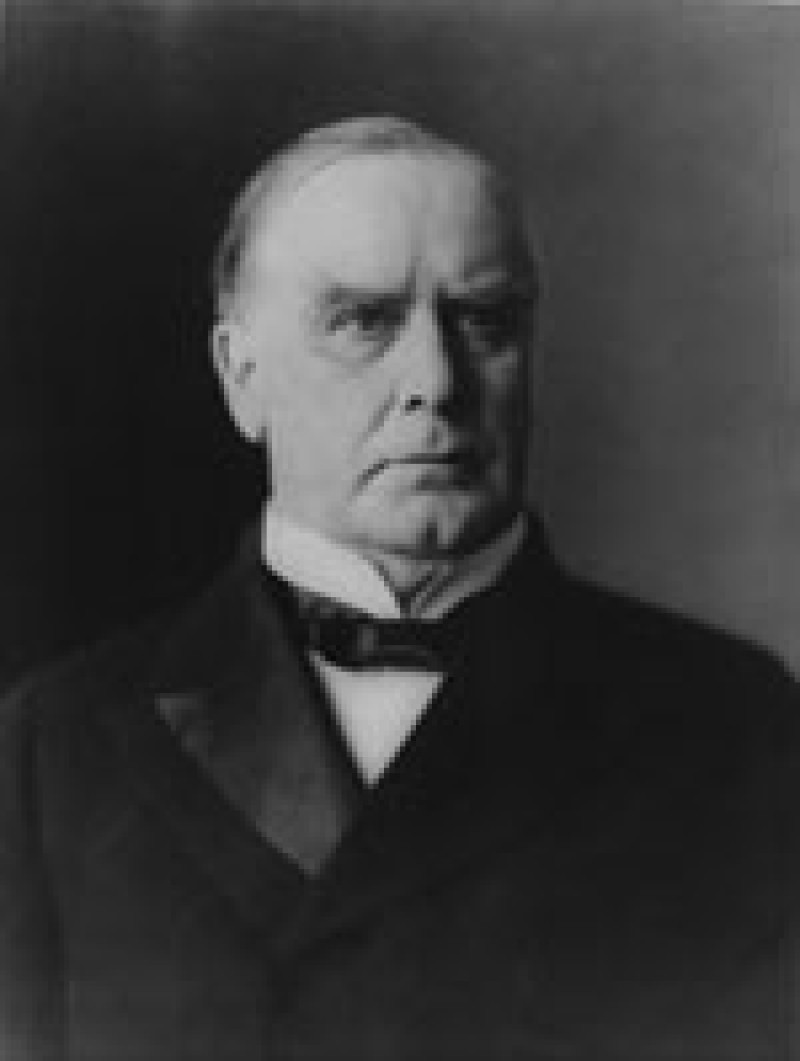William McKinley (Jan. 29, 1843 - Sept. 14, 1901)
William McKinley, 25th president of the United States, was born in Niles, Ohio. McKinley went to school in Niles and later in Poland, Ohio. When the Civil War began, McKinley was the first man in Poland, Ohio, to volunteer. During the fighting at Antietam in 1862, McKinley displayed bravery in combat when he brought food and coffee to his regiment under heavy enemy fire.
After the war, McKinley worked in the law office of Judge Charles E. Glidden of Youngstown and spent some time at the Albany Law School in New York. Admitted to the Ohio bar in 1867, he opened a practice in Canton where he maintained a home until his death.
In 1876 McKinley was elected to Congress from Ohio's 17th District. He quickly identified himself with the protective tariff and became a spokesman for the economic nationalism that protection represented.
In 1891 McKinley ran for governor of Ohio against the incumbent, James E. Campbell, and was elected. In 1892 McKinley enjoyed some support as a presidential candidate against President Benjamin Harrison (1833-1901), but he was the permanent chairman of the Republican National Convention and resisted efforts to have his name placed in nomination.
During the 1894 congressional elections, McKinley made 371 speeches for party candidates and emerged as the most prominent candidate for the presidential nomination in 1896. When McKinley took office on March 4, 1897, the presidency was in eclipse. Relations with the press were in disarray, and the institution was not prepared for the rapidly expanding duties of the office. Though he never expressed any large theories of presidential power, McKinley proved to be a forceful executive.
The most important foreign policy question that McKinley faced was the rebellion against Spanish rule in Cuba that had been going on since 1895. Close economic ties between the United States and Cuba aroused interest in the war. McKinley believed that Spain should not be granted unlimited time in which to suppress the uprising. He also believed that Spanish tactics must be humane and limited.
The Spanish in Cuba who were opposed to the autonomy program rioted on Jan. 12, 1898, convincing the president that Spain was not going to meet his expectation that the Cubans should obtain true self-rule. With the situation worsening, the battleship Maine was sent to Havana as a sign that friendly relations between Washington and Madrid still existed. Six days later the Maine exploded in Havana harbor, killing 266 of its officers and crew. Sentiment for war mounted.
Spain finally agreed to a suspension of hostilities that did not involve recognition of the rebels, but Madrid balked at Cuban independence. McKinley sent his interventionist message to Capitol Hill on April 11, 1898. Congress gave him the authority he sought on April 19, Spain broke diplomatic relations on April 20, and the two nations were at war by April 25.
During the brief conflict with Spain, McKinley was the central figure. Preparing for a possible war, the U. S. Navy had developed a plan to attack Spain at a vulnerable place, the Philippine Islands, which Madrid could not easily defend. Largely through his efforts, the United States stood victorious in Cuba and the Philippines by mid-July 1898.
By 1900 returning prosperity and the foreign policy record of the administration made McKinley's re-election chances almost certain. The result was another decisive victory for McKinley; he had 292 electoral votes to 155 for Bryan.
The early months of the second term went well. The army captured the main Filipino leader, Emilio Aguinaldo, in March 1901; and the Supreme Court upheld the administration's power over the territories won from Spain in 1898 in the Insular Cases. That summer McKinley traveled across the country and decided to visit the Pan-American Exposition in Buffalo. As he was greeting citizens during a public reception in the Temple of Music, Leon Czolgosz, a self-proclaimed anarchist, shot him twice in the stomach. McKinley lived for eight more days before he died in Buffalo. The nation mourned; McKinley was buried in Canton, and a memorial to him opened there that same year.
Some content and graphic elements featured on webpages related to the Thomas J. Moyer Ohio Judicial Center were used with the permission of the Ohio Historical Society; the Prints and Photographs Division of the Library of Congress; the Office of the Curator of the Supreme Court of the United States and American National Biography Online.
Biography of William McKinley (Jan. 29, 1843 - Sept. 14, 1901)
Citation: Lewis L. Gould. "McKinley, William"; http://www.anb.org/articles/05/05-00507.html; American National Biography Online Feb. 2000. Access Date: Fri Oct 3 09:51:55 2003. Copyright © 2000 American Council of Learned Societies. Published by Oxford Univeristy Press. All Rights Reserved.
Portrait of William McKinley - Library of Congress, Prints & Photographs Division.

